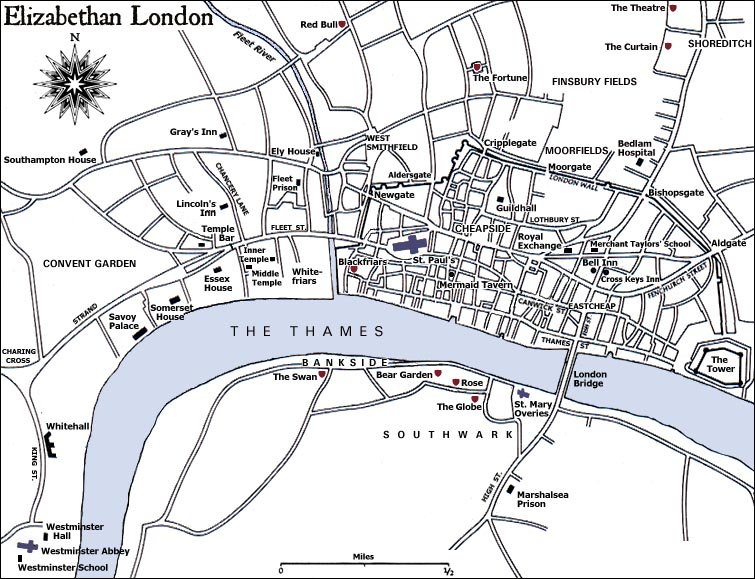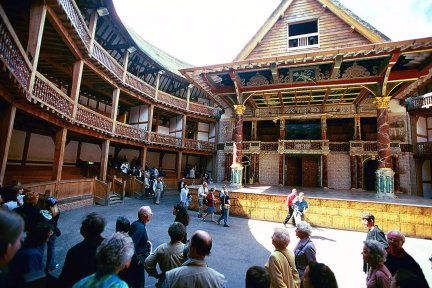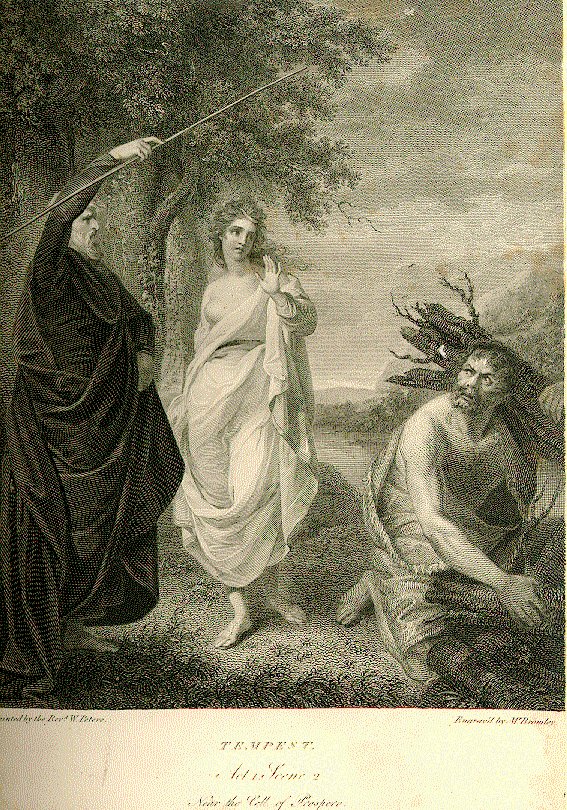

Some study guides, etc:
Penguin Books' Teacher's Guide to The Tempest (high-school level but useful): http://www.penguin.co.nz/shared/WebDisplay/1,,82548_1_10,00.html?cs=10
The e-Notes page for The Tempest: http://www.allshakespeare.com/tempest/
The SparkNotes for The Tempest: http://www.sparknotes.com/shakespeare/tempest/facts.html
Some free MP3 downloads of music from The Tempest: http://www.soundclick.com/bands/0/tempestshakespeare.htm
Key terms: Governance, self-governance (self-control); prose vs. blank verse; counterfeiting; five-act drama; protagonist; plot; sub-plot; rising action; metaphor; indoor vs. outdoor theatre; climax; resolution
The first theater was built in Shoreditch, a section of London; this was The Theatre, built by James Burbage for his company, the Lord Chamberlain's Men--the troupe to which Shakespeare belonged.The company had 10 players, ten hirelings, various musicians, stagehands, and fee gatherers, and 5 boys in training. The average play lasted for three hours, and the company gave performances every afternoon except Sunday. Theaters were closed during Lent. Theaters were also closed during plague epidemics; the companies survived then by going on tour in the countryside with smaller companies. In 1600, London had a population of 200-250,000. Of those, between 18,000 and 24,000 people went to see a play every week.

The Globe Theatre opened in 1599, probably with a performance of Julius Caesar. It was full to its capacity of 2000 people, and the play was a great success. The performance probably started at about 2 p.m. If you went to the the Globe to see Hamlet performed in 1600 or 1601, you would go in the daytime, for a couple of reasons. First, there was no electricity in those days, so there would have been no safe or effective way of lighting the stage enough to do a performance at night. Torches and lanterns would have been too dangerous in a wooden structure whose floor was covered with straw; the city of London burned to the ground twice, and fire was an ever-present fear. Another reason to go to the theatre in the daytime would be the fact that walking around at night, especially for women, was not safe. London had no police force then, and the nighttime streets belonged to the criminals and prostitutes. Even during the day, women never went anywhere unescorted, and at night, people stayed in, behind barred doors and windows, and those who could afford it hired guards.
The Globe was situated on what was then a large tract of empty land; next to it was a bear-baiting pit, and prostitutes plied their trade outside. The theatre was located just across the river from London; technically, it was outside the city limits. This was important, because the censors in the city had a great deal of control over what was allowed and what was not allowed to be performed, and some city administrations were very restrictive. Being outside the city limits gave Shakespeare more artistic freedom--although he still had to stay on the good side of the King or Queen to avoid imprisonment.
 When
you arrived at the theatre, you would take your seat. There were three entrances
to the theater: one for those standing in the Yard (also known as the Pit: the
floor in front of the stage), who paid a penny for admission; one for those in
the middle galleries, who paid two pence, and one for those in the upper tiers,
who paid three pence. During the performance, food and drink were carried around
and sold. If you were of the lower classes, uneducated and poor, you would have
purchased the cheapest ticket for 1 penny and you would stand in the "pit."
Those from the middle and upper classes purchased more expensive seats. The
further away from the pit you could be, the better, because the pit was noisy,
smelly, and often rowdy. The floor of the pit was covered with straw, because
those who stood (or sat or fell down) in the pit were often drunk, and the straw
was needed to soak up the bodily fluids they expelled.
When
you arrived at the theatre, you would take your seat. There were three entrances
to the theater: one for those standing in the Yard (also known as the Pit: the
floor in front of the stage), who paid a penny for admission; one for those in
the middle galleries, who paid two pence, and one for those in the upper tiers,
who paid three pence. During the performance, food and drink were carried around
and sold. If you were of the lower classes, uneducated and poor, you would have
purchased the cheapest ticket for 1 penny and you would stand in the "pit."
Those from the middle and upper classes purchased more expensive seats. The
further away from the pit you could be, the better, because the pit was noisy,
smelly, and often rowdy. The floor of the pit was covered with straw, because
those who stood (or sat or fell down) in the pit were often drunk, and the straw
was needed to soak up the bodily fluids they expelled.
When writing his plays, Shakespeare had to take into account two audiences: those in the gallery seats, and those in the pit. Those in the galleries would be somewhat educated, and interested in the ideas he was exploring. They would be able to appreciate subtle humor and character development. But those in the pit would need action, sex, and slapstick. So when you read Shakespeare's plays, you notice that, after each soliloquy or quiet scene, where the focus is on conversation, there will be a scene in which there is violence or comedy. Today, if you go to a Saturday matinee, the kids in the audience get restless if there's no action; they talk, and get up and walk around, and sometimes even throw things. They hoot if the hero kisses the heroine. This is a mild version of what the people in the pit were like. They were unable to appreciate the subtleties of Hamlet's soliloquy; they wanted a sword fight or a good, bloody murder. And if too much time went by without one, they'd amuse themselves by booing or jeering the people on stage, or throwing rotten fruit or eggs at the actors. Thus, keeping the pit happy was one of Shakespeare's (or any playwright's) major concerns. One of the things he liked most about the Blackfriars Theatre was that it catered to a wealthier and more educated audience, and had no pit.
 In
addition, it was common for one actor to play several minor roles. Shakespeare
had to take this into account, and make sure that he didn't have two characters
on the stage who were being played by the same actor. And he had to make sure
there was enough time for costume changes in between: he couldn't have an actor
leave the stage dressed as a serving maid and return seconds later as a soldier.
In
addition, it was common for one actor to play several minor roles. Shakespeare
had to take this into account, and make sure that he didn't have two characters
on the stage who were being played by the same actor. And he had to make sure
there was enough time for costume changes in between: he couldn't have an actor
leave the stage dressed as a serving maid and return seconds later as a soldier.
Shakespeare's company was the most successful of its day, and his plays
filled the theatres. Many (most?) of the audience in a public performance
would lack formal education and be technically illiterate (this does not
mean that they were unintelligent). But these were people for whom the
spoken word was of greater value than is the case today: they would be
more attentive, more sensitive in listening to patterns of verse and rhyme,
and aware of imagery (word pictures). The
intervals between Shakespeare's "scenes" represent changes in time or place,
but not of scenery, which would be minimal or non-existent. Basic
stage furniture would serve a variety of purposes, but stage properties and costume would be more elaborate
and suggestive. A range of gestures and movements
with conventional connotations of meaning was used, but we are not sure
today how these were performed.
In order to understand a play, we have to work harder than did the Elizabethan or Jacobean audience. To see a play entire (in the theatre or on film), without interruption apart for the interval, may be needed for us to appreciate Shakespeare's strong sense of narrative drive, and to see how the text is not the play but a (loose) blueprint for performance. On the other hand, study of text and editors' notes may be necessary for us to appreciate some of the attitudes the contemporary audience brought into the theatre. Such notes may explain images and highlight patterns or structures which otherwise we might not "hear". They may explain semantic change (changes of meaning) in words or phrases used by the playwright to convey important ideas to his audience. In watching Shakespeare in performance we are not likely ever to enjoy the instant pleasure of experiencing a work of art (like a feature film or soap-opera or first-person novel) which uses conventions and a range of cultural references which we at once understand. What is amazing is that so much is still accessible, and that by adapting the delivery of lines, and giving some visual clues, performers can make the plays work today.
The division of plays into five acts is more apparent to the dramatist (to whom it gives an idea of how the play's narrative structure will appear in performance) than to the audience (though modern audiences often know act and scene numbers). For the student (you), the numbering of acts and scenes is of enormous importance in identifying a given point in the narrative. When quoting a passage, always give act and scene number, while line numbers are helpful, too.
